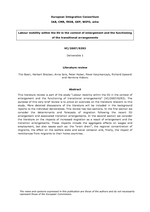Labour Mobility Study
Labour Mobility - Background Analyses - Forecasting potential migration from the New Member States into the EU-15: Review of Literature, Evaluation of Forecasting Methods and Forecast Results
Herbert Brücker, Andreas Damelang and Katja Wolf
in: Labour Mobility - Background analyses
Labour Mobility Study ,
In this background report we review the literature on migration forecasts, evaluate different methods for forecasting migration and present a new approach to forecast the migration potential from the new member states (NMS) into the EU-15. There has been a large literature attempting to forecast the migration from the NMS before enlargement. At a long-run migration potential of about 3 to 5 per cent of the population and an influx of between 200,000 and 300,000 persons, the mainstream of these forecasts is by and large consistent with the actual migration movements from the NMS-8 into the EU-15, while the migration potential from Bulgaria and Romania has been underestimated. Moreover, these studies employed explicitly or implicitly the counterfactual assumption that all EU-15 countries will open their labour markets at the same time, such that they were not able to forecast the substantial changes in regional migration patterns which took place after EU enlargement. While this literature had to rely on coefficients from other countries, the post-Enlargement migration enables us to exploit information on recent migration stocks and flows for forecasts of the migration potential. However, the selective application of transitional arrangements for the free movement of workers has distorted bilateral migration patterns, such that the coefficients derived from bilateral migration movements are likely to be biased. We therefore refer to the EU-15 as a single destination which allows us to circumvent this problem. Moreover, we use information on migration stocks and flows within the EU countries to estimate the migration potential under the conditions of free movement. Based on this approach, we estimate the longrun migration potential from the NMS-8 at about 6 per cent of the population in the sending countries, and the migration potential from the NMS-2 (Bulgaria and Romania) at about 14 per cent of the population in the sending countries. The short-run net inflow of migrants from the NMS-8 is estimated to be at about 240,000 persons p.a., and that from the NMS-2 at about 190,000 persons p.a. These net inflows may decline in the course of the financial crisis, since immigration and return migration are largely determined by the conditions in host countries.
Countries covered: European Union, New EU Member States
Research Areas: Labour, Migration and Income Distribution
